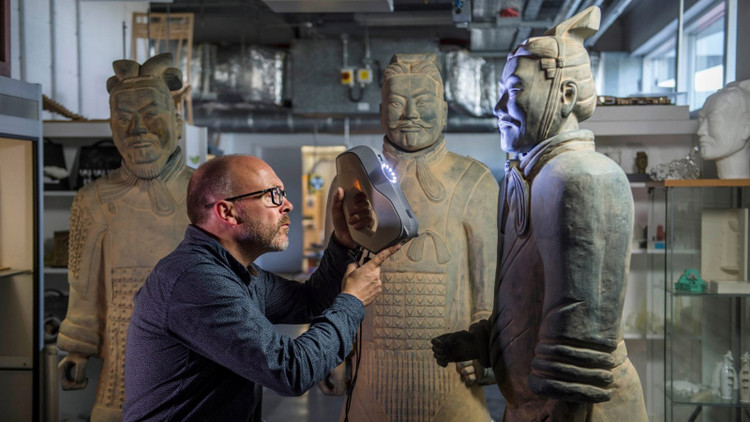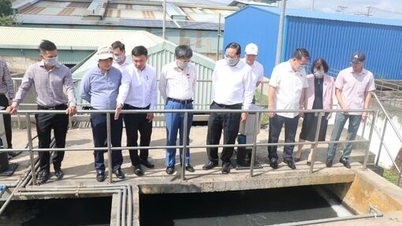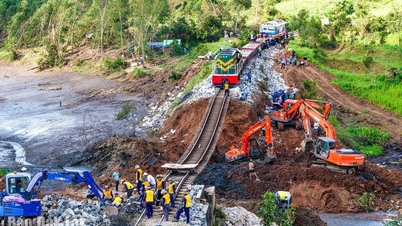During the historic floods from October 27th to now, the Cham tower of Phu Dien (Phu Vinh commune, Hue city) has been submerged in water for a long time. At one point, the tower was almost half submerged. This situation has raised concerns among local people about an ancient structure of great historical and cultural value in Vietnam being seriously affected by natural disasters and floods.
On a global scale, the story of Phu Dien Tower is not an isolated one. Many ancient relics in many countries have suffered from being submerged in water, perhaps only temporarily, but sometimes indefinitely. In that context, many advanced technologies are opening up new hope for the conservation of relics submerged in water for a long time.

Phu Dien Cham Tower has been submerged in water for a long time. Photo: Hoang Anh Tuan / Tien Phong Newspaper.
Modern Technology – New Hope for Waterlogged Relics
First of all, 3D scanning and digital reconstruction technology are becoming indispensable tools. For fragile or submerged relics, direct salvage can cause irreparable damage. Thanks to laser scanning or multi-angle scanning, experts can accurately recreate the shape, size and structure of artifacts without moving them from their original location. The data obtained allows for virtual simulation of artifacts, serving research, display or restoration. Many underwater archaeological projects in the Mediterranean, especially the Antikythera shipwreck in Greece, have applied this technology to store detailed data on each fragment, helping scientists piece together a "picture of the past" without worrying about the risk of destroying the original object.
In parallel, the technology of preserving with polyethylene glycol (PEG) solution – a friendly polymer compound – has proven to be outstandingly effective in stabilizing the structure of organic materials soaked in water for a long time, especially wood. When wood is soaked for too long, the cellulose fibers decompose, making it susceptible to deformation or cracking when dry. PEG has the ability to penetrate deep into the wood structure, replacing water with a stabilizer, helping the object retain its original shape. The Swedish warship Vasa, which sank in 1628 and was salvaged in 1961, is a typical example: decades of PEG misting has helped this giant ship maintain its intact structure until today, becoming a symbol of underwater heritage conservation.

3D scanning and digital reconstruction technology are becoming indispensable tools in heritage conservation. Photo: Lincoln Conservation
Freeze-drying is also being used for leather, paper, fabric, and wood artifacts that have high moisture content. This process removes water from the material by sublimating it directly from ice to vapor, avoiding shrinkage or deformation. This method has saved hundreds of ancient documents and wooden statues from archaeological sites in Egypt and Northern Europe, where moisture and microorganisms are always a potential threat.
In recent years, scientists have also been researching the use of robots and artificial intelligence in underwater archaeology. Diving robots equipped with sensors, spectral cameras and sonar systems can survey areas hundreds of meters deep that are difficult for humans to access. AI will analyze image data, identify objects of archaeological value, and even predict structures buried under layers of mud. This approach not only saves time but also minimizes disturbance to the natural environment around the relic.
When technology becomes the bridge between past and present
However, saving a relic is not only a matter of technology but also a combination of physical preservation and cultural knowledge preservation. With ancient structures submerged in water for thousands of years, preserving their original state is sometimes impossible. Therefore, museums and research institutes are promoting the application of virtual reality (VR) and augmented reality (AR) to “revive” relics in digital space. Viewers can step into a virtual version of a sunken temple or admire artifacts that no longer exist in real life. This technology not only helps the public access heritage but also creates “digital copies” that can last forever, even when the real object is destroyed over time.
In the future, experts expect the combination of nanomaterials, AI and biotechnology to open up a whole new generation of conservation methods. Several European research institutes are testing “good” bacteria that can regenerate the structure of rotten limestone and wood, replacing damaged parts without changing color or durability. Silica nanoparticles are also being tested to strengthen the structure of ceramics and stones that have been submerged in water for a long time.
Overall, technology is playing a key role in the fight to reclaim the past from the hands of time and water. While each relic is a unique case, requiring its own solution, the common point is: humanity has more and more powerful tools to listen, restore and tell stories buried for millennia. And in that journey, technology is not only a means to save heritage, but also a bridge connecting the past with the present - helping the thousand-year-old relics to live on in the memory of people today.
Source: https://khoahocdoisong.vn/cong-nghe-dot-pha-giu-gin-di-san-co-duoi-nuoc-truoc-tac-dong-thien-nhien-post2149066927.html




![[Photo] Cutting hills to make way for people to travel on route 14E that suffered landslides](https://vphoto.vietnam.vn/thumb/1200x675/vietnam/resource/IMAGE/2025/11/08/1762599969318_ndo_br_thiet-ke-chua-co-ten-2025-11-08t154639923-png.webp)





















![[Photo] "Ship graveyard" on Xuan Dai Bay](https://vphoto.vietnam.vn/thumb/1200x675/vietnam/resource/IMAGE/2025/11/08/1762577162805_ndo_br_tb5-jpg.webp)






![[Video] Hue Monuments reopen to welcome visitors](https://vphoto.vietnam.vn/thumb/402x226/vietnam/resource/IMAGE/2025/11/05/1762301089171_dung01-05-43-09still013-jpg.webp)







































































Comment (0)